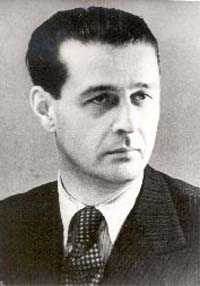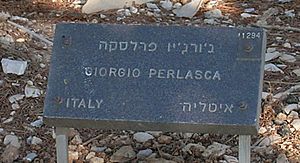Giorgio Perlasca facts for kids
Quick facts for kids
Giorgio Perlasca
|
|
|---|---|
 |
|
| Born | January 31, 1910 |
| Died | August 15, 1992 (aged 82) Padua, Italy
|
| Occupation | Businessman, diplomat |
| Known for | Saving 5,218 Jews from deportation during the Holocaust |
| Awards | |
Giorgio Perlasca (born January 31, 1910 – died August 15, 1992) was an Italian businessman. During World War II, he pretended to be the Spanish Consul-General in Hungary. In the winter of 1944, he saved 5,218 Jews from being sent to Nazi extermination camps. In 1989, Israel honored Perlasca as a Righteous Among the Nations. This title is given to non-Jews who risked their lives to save Jews during the Holocaust.
Contents
Early Life and Beliefs
Perlasca was born in Como, Italy. He grew up in Maserà, near Padua. In the 1920s, he supported a political movement in Italy called Italian Fascism. He fought in a war in Italian East Africa and later in the Spanish Civil War. As a thank you for his service in Spain, he received a special diplomatic pass from Francisco Franco, the leader of Spain.
However, Perlasca became unhappy with fascism. This was especially true after the Italian leader, Benito Mussolini, became allies with Nazism. Mussolini also introduced new laws in 1938 that were unfair to Jewish people.
Helping During World War II
At the start of World War II, Perlasca worked to get supplies for the Italian Army. Later, he became an official Italian diplomat. He was sent to Eastern Europe to buy meat for Italian soldiers fighting on the Russian front.
On September 8, 1943, Italy surrendered to the Allied forces. Italians then had to choose sides. They could join a new government led by Mussolini, which was still allied with Germany. Or, they could stay loyal to the King and join the Allies. Perlasca chose to support the King and the Allies.
Life in Budapest
In Budapest, Hungary, Perlasca was arrested and held in a castle for diplomats. After a few months, he used a medical pass to travel. He asked for safety at the Spanish Embassy. He used his past service in the Spanish war to his advantage. He even changed his first name to "Jorge." Since Spain was neutral in the war, he became a free man.
Perlasca worked with the Spanish diplomat, Ángel Sanz Briz. They worked with other diplomats from neutral countries. Their goal was to help Jews escape from Hungary. Perlasca created a system using "protection cards." These cards placed Jews under the care of different neutral countries. He helped Jews find safety in special houses controlled by embassies. These houses had special rules that made them like their own country's land. This allowed them to offer safety to Jews.
Taking Charge of the Embassy
In November 1944, Sanz Briz left Hungary suddenly. He did not tell Perlasca he was leaving. Perlasca decided to stay in Hungary. The Hungarian government then ordered the Spanish Embassy and the safe houses to be emptied. Perlasca quickly made a false announcement. He said that Sanz Briz was coming back soon. He also announced that he had been appointed as the temporary head of the embassy.
Throughout that winter, Perlasca worked hard. He hid, protected, and fed thousands of Jews in Budapest. He continued to issue safe conduct passes. These passes were based on an old Spanish law from 1924. This law granted citizenship to Jews of Sephardic origin. These were descendants of Jewish people who had been expelled from Spain centuries ago.
In December 1944, Perlasca bravely rescued two boys. They were about to be forced onto a train. He stood up to a German officer at the scene. Another rescuer, the Swedish diplomat Raoul Wallenberg, was also there. Wallenberg later told Perlasca that the officer he challenged was Adolf Eichmann, a high-ranking Nazi. Over 45 days, from December 1, 1944, to January 16, 1945, Perlasca helped save more than 5,000 Jews.
Perlasca also said he stopped a plan to destroy the Budapest Ghetto. This was a part of the city where about 60,000 Jewish people lived. The Nazis had done this in other cities, like Warsaw. Perlasca learned of the plan from the Nazi SS and the Hungarian Arrow Cross Party. He asked to meet directly with the Hungarian interior minister, Gábor Vajna. Perlasca threatened legal and financial actions against Hungary. He claimed this would happen if the plan was not stopped. He said this was for the "3,000 Hungarian citizens" who were actually Spanish residents. After this meeting, the plan to destroy the Budapest Ghetto was canceled.
After the War and Recognition
After the war, Perlasca returned to Italy in August 1945. He wrote a detailed report about his actions. He sent it to the Spanish and Italian governments. However, he was largely ignored. The few groups he wrote to did not show interest. Even a Jewish historian who received Perlasca's report did not share his story publicly at first. Perlasca also had to pay for a car he used during the rescues, which had been destroyed. He struggled financially.
Perlasca did not seek fame. He simply told his story to those he thought should know. He then lived his life quietly. His family only learned about his detailed report in 1980, after he had a stroke. He decided to talk about it with his closest relatives. The full story became public in 1987.
In 1987, a group of Hungarian Jews he had saved found him. They had been searching for him for 42 years. His heroic actions then received wide attention. A book called Banality of Goodness was written about him. It became a bestseller. A TV film, Perlasca – Un eroe Italiano (2005), was also made about his life. In 1989, the Hungarian parliament gave Perlasca their highest national honor. The next year, he was honored in the United States. The Holocaust Museum recognized him as a Righteous Among the Nations.
In October 1991, he received a high Italian honor. The Italian Senate also approved a special pension for him. However, Perlasca refused the money.
Giorgio Perlasca died from a heart attack in Padua on August 15, 1992.
Decorations and Honors
- In 1987, Perlasca became an honorary citizen of Israel. He was honored by the Yad Vashem Holocaust Memorial Museum. A special stone monument (stele) and a forest of 10,000 trees were dedicated to him.
- Yad Vashem named Perlasca a Righteous Among the Nations in 1989.
- Star of Merit, Hungary, 1989
- Knesset Medal, Israel, 1989
- Town Seal of Padova, Italy, 1989
- Wallenberg Medal, United States, 1990
- Medal of Remembrance of the United States Holocaust Memorial Council, USA, 1990
- Invited to lay the first stone of the Holocaust Museum in Washington, USA, 1990
- Knight Grand Cross, Spain, 1991
- 1st Class, Knight Grand Cross (Italy), 1991
- Gold Medal for Civil Bravery (Italy), 1992
- A bust (sculpture of his head and shoulders) of Perlasca was created in Budapest.
- The Raanana Symphonette Orchestra created a special musical piece, "His Finest Hour," to honor Perlasca. It premiered in 2014.
Places Named After Him
- Inside Raoul Wallenberg Memorial Garden (Dohàny street 2)
- Giorgio Perlasca Kereskedelmi, Vendéglátóipari Szakközépiskola és Szakiskola (Giorgio Perlasca Highschool)
Movies About Him
- Perlasca – Un eroe Italiano (2005)
- El ángel de Budapest
Songs About Him
- Sandy Cash: Giorgio Perlasca
- David Ben Reuven: The Rescuers
Stamps Featuring Him
- Italian stamp of 2010
- Israeli stamp of 1998
Books About Him
- Giorgio Perlasca, L'impostore, 2007, Il Mulino. ISBN: 9788815060891 (Perlasca's own story, published after his death)
- Enrico Deaglio, La banalità del bene. Storia di Giorgio Perlasca, 1991, Feltrinelli. ISBN: 9788807070242
See also
 In Spanish: Giorgio Perlasca para niños
In Spanish: Giorgio Perlasca para niños



